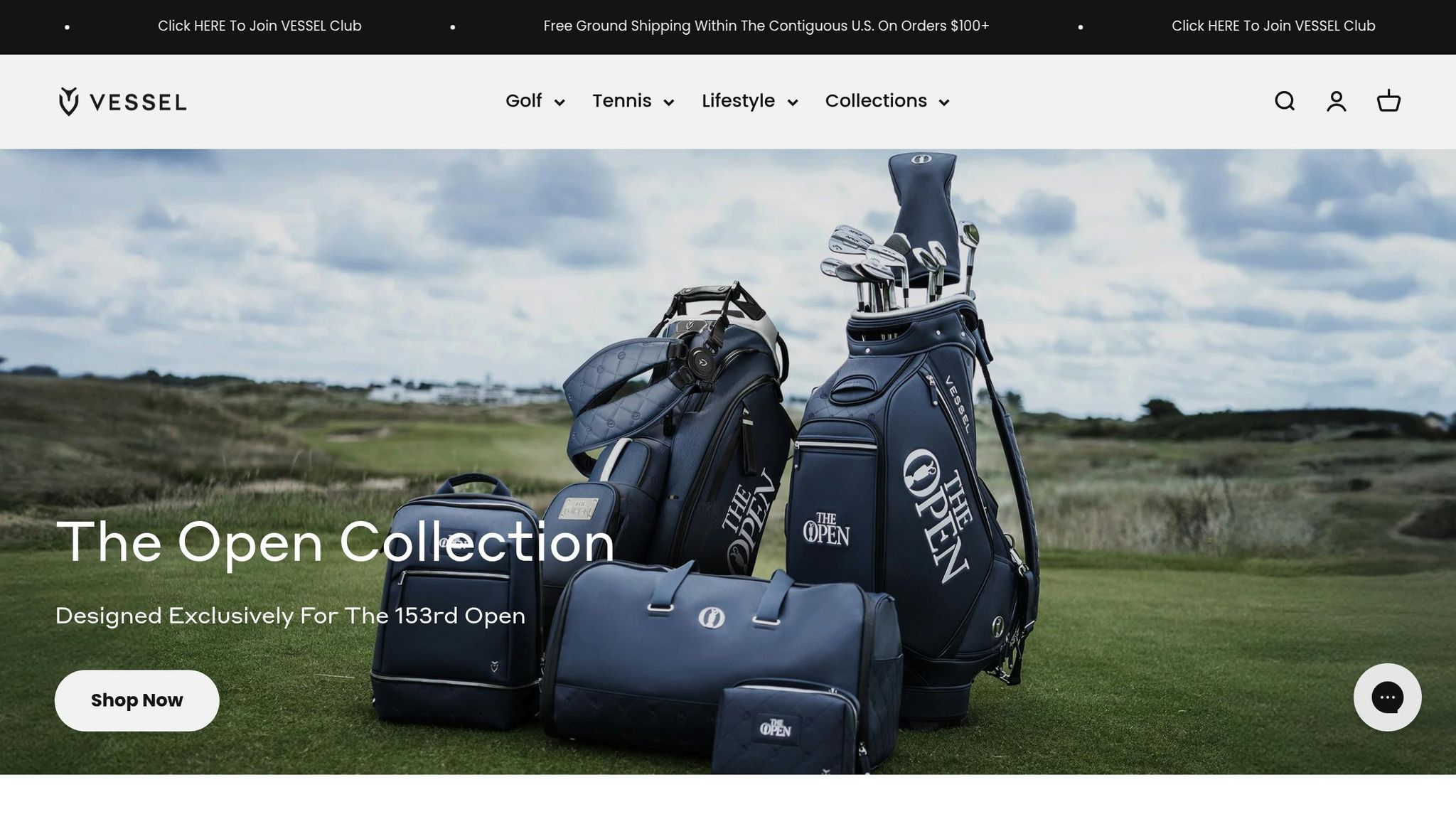Japanese design is reshaping golf bags by combining style with practical use. Unlike U.S. brands that focus on tech-heavy features, Japanese designs prioritize simplicity, quality, and nature-inspired artistry. This approach addresses common frustrations with traditional golf bags, such as excessive weight and cluttered layouts. Here’s a quick look at the three core principles driving this trend:
- Minimalism: Lightweight materials, fewer compartments, and intuitive layouts make these bags easier to carry and use.
- Expert Craftsmanship: High-quality materials and precise detailing ensure durability and long-lasting performance.
- Nature-Inspired Patterns: Subtle designs influenced by elements like waves and mountains add elegance without sacrificing functionality.
Japanese golf bags are gaining traction in the U.S., offering a refined alternative to mass-produced options. The market is projected to grow from $1.6 billion in 2024 to $2.4 billion by 2033, underscoring their rising appeal. For golfers, these bags provide lighter, more organized, and visually striking solutions for the course.
KINTSUGI | A Limited Edition Golf Collection by VESSEL

Minimalism: Simple Design for Better Function
Japanese minimalism takes the concept of "less is more" to a whole new level, transforming clutter into streamlined efficiency. By stripping away unnecessary elements, this design philosophy enhances performance and reduces weight, making equipment feel intuitive and effortless to use.
"Minimalism isn’t just a design trend – it’s a mindset that can actually enhance performance." – Samuel Goulden, Author
At its heart, Japanese minimalism is inspired by principles like Kū (emptiness) and Mu (nothingness), which emphasize creating space by eliminating excess. This approach allows for greater focus and functionality.
Clean Layouts and Lightweight Materials
Minimalist golf bags are designed with simplicity in mind, featuring fewer compartments that are strategically organized. Each pocket has a clear purpose, cutting down on the hassle of searching through unnecessary clutter.
One of the standout features of these bags is their weight – or lack thereof. Traditional golf bags typically weigh between 7–10 pounds, but minimalist versions often range from just 2–4 pounds. This dramatic weight reduction, often 30–50% lighter than standard bags, is achieved through the use of materials like nylon and carbon fiber components.
Modern minimalist bags also incorporate thoughtful features without adding bulk. Magnetic closures replace heavier zippers for easier access, while convertible strap systems adapt to different carrying preferences. Carbon fiber legs provide sturdy support while keeping the overall weight low.
The layout of these bags reflects intentional Japanese design principles. Clubs are organized from longest to shortest, with shorter clubs positioned at the bottom to protect graphite shafts during transport. This systematic arrangement not only prevents damage but also reduces setup time, offering golfers a smoother, more efficient experience.
Benefits for American Golfers
For American golfers, minimalist golf bags are proving to be a game-changer. A lighter bag means less strain over an 18-hole round, allowing players to focus on their swing instead of battling fatigue. These designs also encourage smarter club selection, as limited space pushes golfers to carry versatile clubs capable of handling multiple scenarios.
"The best minimalist golfers aren’t hindered by having fewer clubs – they’re liberated by it. They learn to be more creative with the clubs they have, creating different shots and trajectories as needed." – David Leadbetter, Golf instructor
Durable materials like nylon ensure these bags can withstand various weather conditions with little upkeep. Their compact design makes them easier to load into golf carts, carry up stairs, and fit into car trunks – features especially appreciated by golfers who prefer walking the course.
Expert Craftsmanship: Quality and Long-Lasting Design
Japanese craftsmanship brings a new level of quality and attention to detail to minimalist golf bag designs, blending functionality with durability. At the heart of this craftsmanship is the philosophy of Monozukuri – a dedication to the art and science of making things. This philosophy emphasizes creating products that not only perform exceptionally but also age gracefully, turning everyday golf bags into premium, long-lasting equipment.
Unlike mass production, Japanese craftsmanship values precision and the integrity of each component over speed or cost-cutting. Every stitch and seam is meticulously executed to ensure durability and maintain performance over time. This unwavering commitment to quality ensures that every design element contributes to exceptional functionality and reliability.
Hand-Finished Details and Premium Materials
One of the standout features of Japanese-crafted golf bags is their intricate detailing and use of high-quality materials. Models like the Miura Golf Player IV Pro Stand Bag and VLS Lux Stand Bag showcase refined touches such as elegant Boro stitching, genuine and synthetic leather accents, antimicrobial linings, and microfiber dividers that protect clubs from scratches. Reinforced stitching not only enhances the bag’s aesthetic appeal but also evenly distributes stress, reducing the risk of wear and tear.
These modern designs often draw inspiration from traditional Japanese techniques. For instance, some manufacturers incorporate elements of Kintsugi – the art of repairing pottery with gold or silver lacquer – to celebrate resilience and the beauty of imperfection over time.
"Every material, from leather to canvas, undergoes a thorough selection process to ensure excellence." – Koyama Golf Bag Factory
Custom Options for U.S. Businesses
For American businesses looking to offer high-end golf bags, adopting Japanese craftsmanship principles can provide a distinct competitive edge. By embracing the Kaizen approach, which focuses on continuous improvement, companies can refine their manufacturing processes while maintaining premium quality. This method allows for the integration of personalized features, such as logo embroidery, custom material choices, and unique color combinations, without compromising on durability or performance.
Prioritizing high-quality materials and thoughtful design ensures that U.S. businesses can deliver products that resonate with their customers’ needs while aligning with their branding.
Handcrafted vs. Mass-Produced Golf Bags
Handcrafted golf bags stand apart from their mass-produced counterparts, offering unmatched quality and personalization. Take Koyama Golf Bag Factory, for example. Since its founding in 1977, Koyama has specialized in custom-made golf bags that reflect genuine Japanese craftsmanship. Each bag is tailored to the customer’s preferences, incorporating durable materials and meticulous attention to detail.
Mizuno is another example of precision-driven Japanese manufacturing. Since 1998, Mizuno has employed a six-step Grain Flow Forging process in Hiroshima, using 1,200°F forges to craft individual iron heads from single billets of steel. This process ensures tight tolerances and delivers an exceptional feel for golfers.
"Using the right tools enhances the joy of golf, ultimately leading to an improvement in skill." – Koyama Golf Bag Factory
Investing in handcrafted golf bags means choosing quality and longevity. While the upfront cost may be higher, these bags are built to last, making them an excellent investment for serious golfers who value performance and durability.
Nature-Inspired Patterns: Art That Works
While streamlined minimalism and precise craftsmanship bring a modern edge to golf bags, nature-inspired patterns introduce an artistic touch that blends style with function. These designs, rooted in Japanese aesthetics, transform golf bags into more than just equipment – they become pieces of art on the course. Drawing from natural elements like waves, mountains, and the changing seasons, these patterns reflect the philosophy of Shinto, which celebrates the unity of nature and deeply influences Japanese culture.
The beauty of these patterns lies in their ability to create depth through intentional use of space and form. Traditional techniques, such as shibori dyeing, showcase this approach. For instance, the Murase family, who have mastered this craft for five generations at Suzusan textiles, use intricate methods of twisting and tying fabrics to create areas untouched by dye. These untouched spaces add contrast and depth, enhancing the overall design.
"Most likely to succeed in defining Japanese aesthetics is a net of associations composed of listings or jottings, connected intuitively, that fills in a background and renders the subject visible. Hence the Japanese uses for juxtaposition, for assembling, for bricolage." – Donald Richie
Modern golf bag makers have embraced these traditional principles, adapting them to create designs that are both visually captivating and functionally efficient. The balance between filled and empty spaces ensures that these patterns remain engaging yet practical, offering a unique aesthetic appeal throughout a round of golf.
Japanese Patterns for American Golfers
Japanese nature motifs have found a warm reception among American golfers, who appreciate their sophisticated designs and subtle elegance. Patterns inspired by waves, mountains, and seasonal elements like cherry blossoms or autumn leaves bring a sense of harmony while also serving practical purposes, such as defining pockets and compartments.
Kintsugi-inspired designs, in particular, resonate with American golfers. This art form, which involves repairing broken pottery with gold to highlight its flaws, aligns with the sport’s emphasis on growth through challenges. Similarly, mountain and wave patterns reflect the Japanese concept of Ma, the thoughtful use of space and pauses, translating into bag designs that are both visually balanced and highly organized.
"Just as a golfer learns from their mistakes and grows stronger with each challenge, the art of Kintsugi teaches us to embrace our flaws and find beauty in the broken." – Vessel Golf
These designs not only appeal to the eye but also seamlessly integrate practical features, making them ideal for the golf course.
Weather-Resistant Design for Outdoor Use
Beyond their artistic charm, these patterns are crafted to withstand the unpredictable conditions golfers face throughout the year. The combination of aesthetic beauty and durable weatherproofing ensures that these designs remain both functional and visually striking.
For example, Sun Mountain‘s WeatherMax Stand Bag features a WeatherMax fabric that resists water and UV rays, maintaining the vibrancy of Japanese-inspired patterns even under intense sun exposure. Similarly, the H2NO Lite Cart Bag incorporates waterproof zippers, sealed seams, and an integrated rain hood, protecting both the bag’s contents and its decorative designs.
Integrating weather-resistant features with artistic patterns requires thoughtful design. For instance, waterproof zippers and seams can be placed in ways that complement flowing wave patterns or mountain silhouettes, maintaining the natural harmony of the design. As Tanizaki Jun’ichirō once reflected:
"The quality that we call beauty, however, must always grow from the realities of life, and our ancestors, forced to live in dark rooms, presently came to discover beauty in shadows, ultimately to guide shadows towards beauty’s ends."
This philosophy inspires the creation of golf bags that are not only durable and reliable but also celebrate the natural world that influences both the game of golf and traditional Japanese art.
sbb-itb-4fa7e8b
Using Japanese Design with Keep Perfect Golf

Keep Perfect Golf takes the timeless principles of Japanese design and blends them seamlessly with performance-focused features to create custom golf bags. Their approach combines minimalism, expert craftsmanship, and nature-inspired artistry to craft bags that are as functional as they are visually striking. By offering comprehensive OEM/ODM services, Keep Perfect Golf handles everything – from the initial design concept to worldwide delivery. Their services include product development, direct factory production, quality assurance, warehousing, and global shipping. With over 200 global partners, they’ve built a system tailored to meet the needs of American golfers.
Custom Golf Bags: From Concept to Completion
The journey to creating your custom golf bag starts with defining your vision for incorporating Japanese design elements. Keep Perfect Golf offers a wide range of customization options, such as materials, colors, embroidery, pocket layouts, and divider configurations. These choices allow you to infuse your bag with minimalist aesthetics, intricate craftsmanship, and nature-inspired patterns.
You can select premium materials and refine every detail – from color schemes to finishing touches – capturing the elegance of Japanese minimalism. During the design phase, you’ll choose how to integrate these principles into your bag. Whether it’s through clean, uncluttered layouts, patterns inspired by nature (like mountain silhouettes or wave motifs), or subtle hand-finished accents, the possibilities are extensive. Personalization options also include embroidery, custom color palettes, and logos that align with your preferred aesthetic. Complimentary heat transfer printing is available, with affordable upgrades for additional branding.
Functionality is just as important as design. You can enhance your bag’s practicality by adding features like multiple dividers for better organization, waterproof zippers for weather resistance, and specialized pockets that balance utility with visual harmony. With strict quality control, dedicated storage solutions, and efficient global shipping, Keep Perfect Golf ensures that your custom bags are delivered seamlessly to U.S. customers.
Balancing Style and Functionality
Merging Japanese design with American practicality creates golf bags that excel both in style and performance. Premium accents and minimalist layouts are thoughtfully combined to maintain functionality on the course.
While Japanese-inspired designs often emphasize simplicity and clean lines, the needs of American golfers – like quick access to essentials – are never overlooked. Smartly integrated storage solutions, such as hidden or seamlessly designed pockets, provide convenience without compromising the bag’s sleek appearance.
Weather durability is another critical aspect. Opting for weatherproof materials ensures that the bag maintains its design integrity and performs well under various conditions.
For businesses, incorporating Japanese aesthetics into custom golf bags can set your brand apart in the competitive U.S. market. These bags typically range in price from $150 to $500 or more, depending on materials, design complexity, and order size. They offer a unique way to leave a lasting impression. Keep Perfect Golf also provides free design services to help translate your vision into practical specifications, guiding you through choices like fabric selection, pattern placement, and functional features.
The end result is a golf bag that beautifully reflects Japanese design values while meeting the practical needs of American golfers – a product that looks stunning and performs flawlessly on the course.
Conclusion: Better Golf Bags Through Japanese Design
Blending Japanese design principles with modern golf features has led to golf bags that are lighter, tougher, and visually striking. This fusion of simplicity and precision aligns perfectly with the high-quality craftsmanship that defines these products.
By focusing on minimalism, these bags eliminate unnecessary extras while keeping essential features intact, making them easier to carry and maneuver on the course. With expert craftsmanship and nature-inspired designs, they deliver durability and weather-resistant performance that outshines mass-produced alternatives.
This approach to design emphasizes fewer but smarter features, resulting in golf bags that enhance the overall experience for players.
Keep Perfect Golf integrates these principles at every stage – from concept to delivery – showing how traditional aesthetics and modern functionality can come together to create golf bags that meet the demands of today’s players. For brands aiming to stand out in a crowded market, adopting these design principles offers a clear way to deliver products that excel in both style and performance.
FAQs
How do Japanese design principles make golf bags more functional and visually appealing?
Japanese design principles bring a distinctive approach to golf bags, blending practicality and artistry through minimalism, superior craftsmanship, and a connection to nature. These bags embrace clean, simple designs that eliminate unnecessary clutter, making it easier to organize and access your equipment while on the course.
The meticulous craftsmanship ensures durability and incorporates high-quality materials, while subtle, nature-inspired details – like traditional quilting or delicate gold accents – infuse the bags with a refined aesthetic. The result is a golf bag that doesn’t just serve its purpose but also stands out as a harmonious mix of functionality and timeless elegance.
How do nature-inspired patterns in golf bag designs enhance the golfing experience?
Nature-Inspired Patterns in Golf Bag Designs
Golf bag designs that draw inspiration from nature aren’t just about looking good – they tap into something deeper. By incorporating patterns that mimic trees, flowers, or natural textures, these designs help golfers feel more connected to the outdoors. This connection can create a calming effect, helping players stay relaxed and focused while navigating the course.
What’s more, these patterns often resonate with golfers who value eco-friendly choices. They reflect a mindful approach to design, appealing to those who care about sustainability. While these designs won’t directly improve your swing or physical performance, the mental boost they provide – less stress and sharper focus – can make a noticeable difference in your overall game.
How can golfers and businesses in the U.S. benefit from incorporating Japanese design principles into their golf equipment?
Golfers and businesses across the U.S. can benefit greatly by incorporating Japanese design principles like precision craftsmanship, minimalist aesthetics, and a commitment to quality and detail. These values not only improve the performance and longevity of golf equipment but also bring a refined, elegant style that sets products apart in a crowded market.
Japanese craftsmanship is all about meticulous attention to detail and using the finest materials, resulting in golf gear that combines reliability with sophistication. For American manufacturers, adopting these principles offers a way to create premium products that appeal to players looking for standout designs and top-tier functionality. For golfers, this blend of artistry and performance can enhance their experience on the course, making every swing feel more connected and purposeful.

